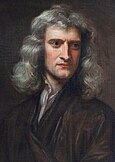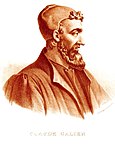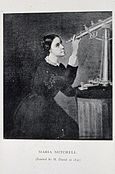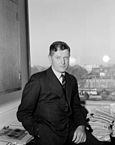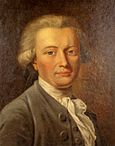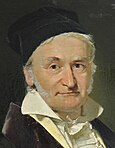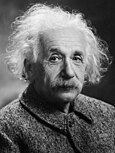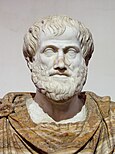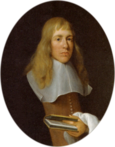Portal:Science/Featured biography
Usage
[edit]The layout design for these subpages is at Portal:Science/Featured biography/Layout.
- Add a new Selected biography to the next available subpage.
- Update "max=" to new total for its {{Random portal component}} on the main page.
Selected biographies list
[edit]Biographies 1–20
[edit]Portal:Science/Featured biography/1
Isaac Newton, English physicist, mathematician, astronomer, inventor, philosopher and alchemist. A man of profound genius, he is widely regarded as the most influential scientist in history. He is associated with the scientific revolution and the advancement of heliocentrism. Among his scientific accomplishments, Newton wrote the Philosophiae Naturalis Principia Mathematica, wherein he described universal gravitation and, via his laws of motion, laid the groundwork for classical mechanics. With Gottfried Wilhelm Leibniz he is credited for the development of differential calculus. Newton was the first to promulgate a set of natural laws that could govern both terrestrial motion and celestial motion, and is credited with providing mathematical substantiation for Kepler's laws of planetary motion, which he expanded by arguing that orbits (such as those of comets) could include all conic sections (such as the ellipse, hyperbola, and parabola).
Portal:Science/Featured biography/2
Richard Phillips Feynman (May 11, 1918 – February 15, 1988) was one of the most influential American physicists of the 20th century, expanding greatly upon the theory of quantum electrodynamics. As well as being an inspiring lecturer and amateur musician, also later he became a member of the panel which investigated the Space Shuttle Challenger disaster. For his work on quantum electrodynamics, Feynman was one of the recipients of the Nobel Prize in Physics in 1965, along with Julian Schwinger and Shin-Ichiro Tomonaga.
Feynman was a keen and influential popularizer of physics in both his books and lectures. He is famous for his many adventures, detailed in the books Surely You're Joking, Mr. Feynman!, What Do You Care What Other People Think? and Tuva or Bust!. Posthumously, Feynman is often credited with helping catalyze the field of nanotechnology through his December 1959 talk called There's Plenty of Room at the Bottom. Richard Feynman was, in many respects, an eccentric and a free spirit.
Portal:Science/Featured biography/3 Aristarchus (310 BC - c. 230 BC) was a Greek astronomer and mathematician, born on the island of Samos, in ancient Greece. He was the first Greek astronomer to propose a heliocentric model of the Solar System, placing the Sun, not the Earth, at the center of the known universe (hence he is sometimes known as the "Greek Copernicus"). His astronomical ideas were not well-received and were displaced by those of Aristotle and Ptolemy, until they were successfully revived and developed by Copernicus nearly 2000 years later. The Aristarchus crater on the Moon was named in his honor.
Aristarchus believed the stars to be very far away, and saw this as the reason why there was no visible parallax, that is, an observed movement of the stars relative to each other as the Earth moved around the Sun.
Portal:Science/Featured biography/4 Rosalind Elsie Franklin (25 July 1920 - 16 April 1958) was an English chemist and X-ray crystallographer who made critical contributions to the understanding of the fine molecular structures of DNA, RNA, viruses, coal, and graphite. Franklin is best known for her contribution to the discovery of the structure of DNA in 1953, while working at King's College London under the direction of physicist John Randall. By the time the 1962 Nobel Prize for Physiology and Medicine was awarded to Crick, Watson, and her colleague Wilkins, she had been dead for 4 years. She subsequently became an icon in feminist literature.
Portal:Science/Featured biography/5 Francis Crick, Francis Harry Compton Crick OM FRS (8 June 1916 – 28 July 2004), was a British molecular biologist, physicist, and neuroscientist, and most noted for being one of the co-discoverers of the structure of the DNA molecule in 1953. He, James D. Watson and Maurice Wilkins were jointly awarded the 1962 Nobel Prize for Physiology or Medicine "for their discoveries concerning the molecular structure of nucleic acids and its significance for information transfer in living material" .[2]
Portal:Science/Featured biography/6 Wolfgang Ernst Pauli (April 25, 1900 – December 15, 1958) was an Austrian physicist noted for his work on the theory of spin, and in particular the discovery of the Exclusion principle, which underpins the whole of chemistry and quantum mechanics.
He seldom published papers, preferring lengthy correspondences with colleagues (such as Bohr and Heisenberg, with whom he had close friendships.) Many of his ideas and results were never published and appeared only in his letters, which were often copied and circulated by their recipients. Pauli was apparently unconcerned that much of his work thus went uncredited.
Portal:Science/Featured biography/7
Claudius Galenus of Pergamum (129-200 AD), better known in English as Galen, was an ancient Greek physician. His views dominated European medicine for over a thousand years. From the modern viewpoint, Galen's theories were partially correct and partially flawed: he demonstrated that arteries carry blood rather than air, and conducted the first studies of nerve, brain, and heart function. He also argued that the mind was in the brain, not in the heart as Aristotle had claimed.
However, much of Galen's understanding is flawed from the modern point of view. For example, he did not recognize blood circulation and thought that venous and arterial systems were separate. This view did not change until William Harvey's work in the 17th century.
Portal:Science/Featured biography/8
Leonhard Euler (April 15, 1707 Basel, Switzerland – September 18, 1783 St Petersburg, Russia) was a Swiss mathematician and physicist. He is considered to be the dominant mathematician of the 18th century and one of the greatest mathematicians of all time; he is certainly among the most prolific, with collected works filling over 70 volumes. Euler developed many important concepts and proved numerous lasting theorems in diverse areas of mathematics, including calculus, number theory, and topology. In the course of this work, he introduced much of modern mathematical terminology, defining the concept of a function, and its notation, such as sin, cos, and tan for the trigonometric functions.
Portal:Science/Featured biography/9
Emil Adolf von Behring (March 15, 1854 – March 31, 1917) was born at Hansdorf, Eylau, Germany (as Emil Adolf Behring). Between 1874 and 1878, he studied medicine at the Army Medical College in Berlin. He was mainly a military doctor and then became Professor of Hygienics within the Faculty of Medicine at the University of Marburg. Behring was the discoverer of diphtheria antitoxin and attained a great reputation by that means and by his contributions to the study of immunity. He won the first Nobel Prize in Physiology or Medicine in 1901 for developing a serum therapy against diphtheria (this was worked on with Emile Roux) and tetanus. The former had been a scourge of the population, especially children, whereas the other was a leading cause of death in wars, killing the wounded.
Portal:Science/Featured biography/10
Santiago Ramón y Cajal (May 1, 1852 – October 17, 1934) was a famous Spanish histologist, physician, and Nobel laureate, and is considered to be one of the founders of modern neuroscience. His most famous studies were on the fine structure of the central nervous system. Cajal used a histological staining technique developed by his contemporary, Camillo Golgi, allowing him to resolve, in detail, the structure of individual neurons. This led him to conclude that nervous tissue was a continuous reticulum (or web) of interconnected cells, much like those in the circulatory system. Using Golgi's method, Ramón y Cajal reached a very different conclusion; he postulated that the nervous system is made up of billions of separate neurons and that these cells are polarized. Rather than forming a continuous web, Cajal suggested that neurons communicate with each other via specialized junctions called "synapses". This hypothesis became the basis of the neuron doctrine, which states that the individual unit of the nervous system is a single neuron. Electron microscopy later showed that a plasma membrane completely enclosed each neuron, supporting Cajal's theory, and weakening Golgi's reticular theory.
Portal:Science/Featured biography/11
Maria Mitchell (August 11, 1818 – June 28, 1889) was an American astronomer. Born on Nantucket Island, she was a first cousin four times removed of Benjamin Franklin.
Her parents were Quakers who, unconventionally for their time, insisted on giving her the same quality of education that boys received. She worked as a librarian and also pursued astronomy at her father's observatory.
Using a telescope, she discovered "Miss Mitchell's Comet" (Comet 1847 VI, modern designation is C/1847 T1) in the autumn of 1847. Some years previously, King Frederick VI of Denmark had established gold medal prizes to each discoverer of a "telescopic comet" (too faint to be seen with the naked eye). The prize was to be awarded to the "first discoverer" of each such comet (note that comets are often independently discovered by more than one person). She duly won one of these prizes, and this gave her worldwide fame, since the only previous woman to discover a comet had been Caroline Herschel.
Portal:Science/Featured biography/12 Michio Kaku (Kanji: 加来 道雄) (born January 24, 1947 in the United States) is a Japanese American theoretical physicist, tenured professor, and co-creator of string field theory, a branch of string theory.
Dr. Kaku is the author of several scholarly, Ph.D.-level textbooks and has had more than 70 articles published in physics journals covering topics such as superstring theory, supergravity, supersymmetry, and hadronic physics. He is also known as an author of popular science books, including the best-sellers Beyond Einstein, Visions, Hyperspace, and Parallel Worlds, and the host of several radio shows, as well as being a popular figure in science television shows due to his accessible approach to the layman on explaining complex physics.
Portal:Science/Featured biography/13
Brian Greene (born February 9, 1963, New York), is a physicist at Columbia University. His book The Elegant Universe: Superstrings, Dimensions, and the Quest for the Ultimate Theory was a finalist for the Pulitzer Prize in nonfiction, and winner of The Aventis Prizes for Science Books in 2000. The Elegant Universe was later made into a PBS television special with Dr. Greene as the narrator. His second book, The Fabric of the Cosmos (2004), is about space, time, and the nature of the universe. Aspects covered in this book include non-local particle entanglement as he relates to special relativity and basic explanations of string theory. It is an examination of the very nature of matter and reality, covering such topics as spacetime and cosmology, origins and unification, and including an exploration into reality and the imagination.
Portal:Science/Featured biography/14 Gregor Mendel (1822–1884) was an Austrian monk who is often called the "father of genetics" for his study of the inheritance of traits in pea plants. Mendel showed that there was particular inheritance of traits according to his laws of inheritance.
It was not until the early 20th century that the importance of his ideas were realized. In 1900, his work was rediscovered by Hugo de Vries, Carl Correns, and Erich von Tschermak. His results were quickly replicated, and genetic linkage quickly worked out. Biologists flocked to the theory, while it was not yet applicable to many phenomena, it sought to give a genotypic understanding of heredity which they felt was lacking in previous studies of heredity, which focused on phenotypic approaches.
Portal:Science/Featured biography/15
Sir Frank Macfarlane Burnet (3 September 1899 – 31 August 1985) was an Australian virologist best known for his contributions to immunology. He went on to conduct pioneering research on bacteriophages and viruses at the Walter and Eliza Hall Institute, and served as director of the Institute from 1944 to 1956. His virology research resulted in significant discoveries concerning their nature and replication and their interaction with the immune system.
From the mid-1950s, he worked extensively in immunology and was a major contributor to the theory of clonal selection, which explains how lymphocytes target antigens for destruction. Burnet and Peter Medawar were co-recipients of the 1960 Nobel Prize in Physiology or Medicine for demonstrating acquired immune tolerance. This research provided the experimental basis for inducing immune tolerance, the platform for developing methods of transplanting solid organs.
Portal:Science/Featured biography/16
Johann Georg Adam Forster (November 27, 1754 – January 10, 1794) was a German naturalist, ethnologist, travel writer, journalist, and revolutionary. At an early age, he accompanied his father on several scientific expeditions, including James Cook's second voyage to the Pacific. His report from that journey, A Voyage Round the World, contributed significantly to the ethnology of the people of Polynesia. As a result of the report Forster was admitted to the Royal Society at the early age of twenty-two and came to be considered one of the founders of modern scientific travel literature.
After his return to continental Europe, Forster turned towards academics. From 1778 to 1784 he taught natural history. Most of his scientific work consisted of essays on botany and ethnology, but he also prefaced and translated many books about travels and explorations, including a German translation of Cook's diaries. Forster was a central figure of the Enlightenment in Germany.
Portal:Science/Featured biography/17 Barbara McClintock (June 16, 1902 – September 2, 1992) was a pioneering American scientist and one of the world's most distinguished cytogeneticists. McClintock received her PhD in botany from Cornell University in 1927, where she was a leader in the development of maize cytogenetics. The field remained the focus of her research for the rest of her career. From the late 1920s, McClintock studied chromosomes and how they change during reproduction in maize. She developed the technique to visualize maize chromosomes and demonstrate genetic recombination by crossing-over during meiosis—a mechanism by which chromosomes exchange information. She produced the first genetic map for maize, and she demonstrated the role of the telomere and centromere. She was awarded prestigious fellowships and elected a member of the National Academy of Sciences in 1944.
Portal:Science/Featured biography/18
Carl Friedrich Gauss (30 April 1777 – 23 February 1855) was a German mathematician and scientist of profound genius who contributed significantly to many fields, including number theory, analysis, differential geometry, geodesy, magnetism, astronomy and optics. Sometimes known as "the prince of mathematicians" and "greatest mathematician since antiquity", Gauss had a remarkable influence in many fields of mathematics and science and is ranked as one of history's most influential mathematicians.
Gauss completed Disquisitiones Arithmeticae, his magnum opus, at the age of twenty-one (1798), though it would not be published until 1801. This work was fundamental in consolidating number theory as a discipline and has shaped the field to the present day.
Portal:Science/Featured biography/19
Galileo Galilei (February 15, 1564 – January 8, 1642) was an Italian physicist, astronomer, and philosopher who is closely associated with the scientific revolution. His achievements include improvements to the telescope, a variety of astronomical observations, the first and second laws of motion, and effective support for Copernicanism. According to Stephen Hawking, Galileo has contributed more to the creation of the modern natural sciences than anybody else. He is the "father of modern astronomy," the "father of modern physics," and the "father of science." The work of Galilei is considered to be a significant break from that of Aristotle.
Portal:Science/Featured biography/20 Carl Edward Sagan (November 9, 1934 – December 20, 1996) was an American astronomer, astrobiologist, and highly successful science popularizer. He pioneered exobiology and promoted the Search for Extra-Terrestrial Intelligence (SETI). He is world-famous for writing popular science books and for co-writing and presenting the award-winning 1980 television series Cosmos: A Personal Voyage, which was the most-watched PBS program until Ken Burns' The Civil War in 1990. A book to accompany the program was also published. He also wrote the novel Contact, the basis for the 1997 film of the same name starring Jodie Foster. During his lifetime, Sagan published more than 600 scientific papers and popular articles and was author, co-author, or editor of more than 20 books. In his works, he frequently advocated scientific skepticism, humanism, and the scientific method.
Biographies 21–40
[edit]Portal:Science/Featured biography/21
Albert Einstein () (March 14, 1879 – April 18, 1955) was a German-born theoretical physicist widely known as one of the greatest physicists of all time. He formulated the special and general theories of relativity. In addition, he made significant advancements to quantum theory and statistical mechanics. While best known for the Theory of Relativity (and specifically mass-energy equivalence, E=mc2), he was awarded the 1921 Nobel Prize for Physics for his 1905 (his "wonderful year" or "miraculous year") explanation of the photoelectric effect and "for his services to Theoretical Physics". In popular culture, the name "Einstein" has become synonymous with great intelligence and genius.
Among his many investigations were: capillary action, his special theory of relativity which stemmed from an attempt to reconcile the laws of mechanics with the laws of the electromagnetic field, his general theory of relativity which extended the principle of relativity to include gravitation, relativistic cosmology, critical opalescence, classical problems of statistical mechanics and problems in which they were merged with quantum theory, including an explanation of Brownian motion; atomic transition probabilities, the probabilistic interpretation of quantum theory, the quantum theory of a monatomic gas, the thermal properties of light with a low radiation density which laid the foundation of the photon theory of light, the theory of radiation, including stimulated emission; the construction of a unified field theory, and the geometrization of physics.
Portal:Science/Featured biography/22
Leonardo di ser Piero da Vinci (), April 15, 1452 – May 2, 1519) was an Italian polymath, having been a scientist, mathematician, engineer, inventor, anatomist, painter, sculptor, architect, botanist, musician and writer. Born as the illegitimate son of a notary, Piero da Vinci, and a peasant girl, Caterina, at Vinci in the region of Florence, Leonardo was educated in the studio of the renowned Florentine painter, Verrocchio. Much of his earlier working life was spent in the service of Ludovico il Moro in Milan. He later worked in Rome, Bologna and Venice, spending his final years in France at the home given to him by King François I.
Leonardo has often been described as the archetype of the "Renaissance man", a man whose seemingly infinite curiosity was equalled only by his powers of invention.[1] He is widely considered to be one of the greatest painters of all time and perhaps the most diversely talented person ever to have lived.[2]
It is primarily as a painter that Leonardo was and is renowned. Two of his works, the Mona Lisa and The Last Supper occupy unique positions as the most famous, most reproduced and most parodied portrait and religious painting of all time, their fame approached only by Michelangelo's Creation of Adam.[1] Leonardo's drawing of the Vitruvian Man is also iconic. Perhaps fifteen of his paintings survive, the small number due to his constant, and frequently disastrous, experimentation with new techniques, and his chronic procrastination.[b] Nevertheless, these few works together with his notebooks, which contain drawings, scientific diagrams, and his thoughts on the nature of painting, comprise a contribution to later generations of artists only rivalled by that of his contemporary, Michelangelo.
Portal:Science/Featured biography/23
Werner Karl Heisenberg (5 December 1901 – 1 February 1976) was a German theoretical physicist who was awarded the Nobel Prize for Physics in 1932 "for the creation of quantum mechanics". Heisenberg, along with Max Born and Pascual Jordan, set forth the matrix formulation of quantum mechanics in 1925. In 1927 he published his uncertainty principle, upon which he built his philosophy and for which he is best known. He also made important contributions to the theories of the hydrodynamics of turbulent flows, the atomic nucleus, ferromagnetism, cosmic rays, and subatomic particles, and he was instrumental in planning the first West German nuclear reactor at Karlsruhe, together with a research reactor in Munich, in 1957. Considerable controversy surrounds his work on atomic research during World War II.
Portal:Science/Featured biography/24
Otto Hahn, (8 March 1879 – 28 July 1968) was a German chemist and Nobel laureate, a pioneer in the fields of radioactivity and radiochemistry. He is regarded as "the father of nuclear chemistry".
Hahn was a courageous opposer of Jewish persecution by the Nazi Party and after World War II he became a passionate campaigner against the use of nuclear energy as a weapon. He served as the last President of the Kaiser Wilhelm Society (KWG) in 1946 and as the founding President of the Max Planck Society (MPG) from 1948 to 1960. Considered by many to be a model for scholarly excellence and personal integrity, he became one of the most influential and revered citizens of the Federal Republic of Germany.
Portal:Science/Featured biography/25
Aristotle (Greek: Ἀριστοτέλης Aristotélēs; 384–322 BC) was an Ancient Greek philosopher and polymath. His writings cover a broad range of subjects spanning the natural sciences, philosophy, linguistics, economics, politics, psychology, and the arts. As the founder of the Peripatetic school of philosophy in the Lyceum in Athens, he began the wider Aristotelian tradition that followed, which set the groundwork for the development of modern science.
Portal:Science/Featured biography/26
William Sanford Nye (/naɪ/; born November 27, 1955) is an American science communicator, television presenter, and former mechanical engineer. He is best known as the host of the science education television show Bill Nye the Science Guy (1993–1999) and as a science educator in pop culture. Born in Washington, D.C., Nye began his career as a mechanical engineer for Boeing in Seattle, where he invented a hydraulic resonance suppressor tube used on 747 airplanes. In 1986, he left Boeing to pursue comedy—writing and performing for the local sketch television show Almost Live!, where he regularly conducted wacky scientific experiments.
Aspiring to become the next Mr. Wizard, Nye successfully pitched the children's television program Bill Nye the Science Guy to Seattle's public television station, KCTS-TV. The show—which proudly proclaimed in its theme song that "science rules!"—ran from 1993 to 1998 in national TV syndication. Known for its "high-energy presentation and MTV-paced segments", the program became a hit among kids and adults, was critically acclaimed, and was nominated for 23 Emmy Awards, winning 19, including Outstanding Performer in Children's Programming for Nye himself.
Portal:Science/Featured biography/27
Joseph Priestley FRS (/ˈpriːstli/; 24 March 1733 – 6 February 1804) was an English chemist, Unitarian, natural philosopher, separatist theologian, grammarian, multi-subject educator, liberal political theorist. He published over 150 works, and conducted experiments in several areas of science.
Priestley is credited with his independent discovery of oxygen by the thermal decomposition of mercuric oxide, having isolated it in 1774. During his lifetime, Priestley's considerable scientific reputation rested on his invention of carbonated water, his writings on electricity, and his discovery of several "airs" (gases), the most famous being what Priestley dubbed "dephlogisticated air" (oxygen). Priestley's determination to defend phlogiston theory and to reject what would become the chemical revolution eventually left him isolated within the scientific community.
Portal:Science/Featured biography/28
Barry Voight (/vɔɪt/; born 1937) is an American geologist, volcanologist, author, and engineer. After earning his Ph.D. at Columbia University, Voight worked as a professor of geology at several universities, including Pennsylvania State University, where he taught from 1964 until his retirement in 2005. He remains an emeritus professor there and still conducts research, focusing on rock mechanics, plate tectonics, disaster prevention, and geotechnical engineering.
In April 1980, Voight's publications on landslides, avalanches, and other mass movements attracted the attention of Rocky Crandell of the United States Geological Survey (USGS), who asked him to look at a growing bulge on the Mount St. Helens volcano in the state of Washington. Voight foresaw the collapse of the mountain's north flank as well as a powerful eruption. His predictions came true when St. Helens erupted in May 1980; Voight was then hired by the USGS to investigate the debris avalanche that initiated the eruption. After his work at Mount St. Helens brought him international recognition, Voight continued researching and guiding monitoring efforts at several active volcanoes throughout his career, including Nevado del Ruiz in Colombia, Mount Merapi in Indonesia, and Soufrière Hills, a volcano on the Caribbean island of Montserrat. For his research, publications, and disaster prevention work as a volcanologist and engineer, Voight has been honored with numerous awards, appointments, and medals.
Portal:Science/Featured biography/29
Hilary Whitehall Putnam (/ˈpʌtnəm/; July 31, 1926 – March 13, 2016) was an American philosopher, mathematician, computer scientist, and figure in analytic philosophy in the second half of the 20th century. He contributed to the studies of philosophy of mind, philosophy of language, philosophy of mathematics, and philosophy of science. Outside philosophy, Putnam contributed to mathematics and computer science. Together with Martin Davis he developed the Davis–Putnam algorithm for the Boolean satisfiability problem and he helped demonstrate the unsolvability of Hilbert's tenth problem.
Putnam applied equal scrutiny to his own philosophical positions as to those of others, subjecting each position to rigorous analysis until he exposed its flaws. As a result, he acquired a reputation for frequently changing his positions. In philosophy of mind, Putnam argued against the type-identity of mental and physical states based on his hypothesis of the multiple realizability of the mental, and for the concept of functionalism, an influential theory regarding the mind–body problem. In philosophy of language, along with Saul Kripke and others, he developed the causal theory of reference, and formulated an original theory of meaning, introducing the notion of semantic externalism based on a thought experiment called Twin Earth.
Portal:Science/Featured biography/30
Johannes Kepler (/ˈkɛplər/; German: [joˈhanəs ˈkɛplɐ, -nɛs -] ; 27 December 1571 – 15 November 1630) was a German astronomer, mathematician, astrologer, natural philosopher and writer on music. He is a key figure in the 17th-century Scientific Revolution, best known for his laws of planetary motion, and his books Astronomia nova, Harmonice Mundi, and Epitome Astronomiae Copernicanae, influencing among others Isaac Newton, providing one of the foundations for his theory of universal gravitation. The variety and impact of his work made Kepler one of the founders and fathers of modern astronomy, the scientific method, natural and modern science. He has been described as the "father of science fiction" for his novel Somnium.
Kepler was a mathematics teacher at a seminary school in Graz, where he became an associate of Prince Hans Ulrich von Eggenberg. Later he became an assistant to the astronomer Tycho Brahe in Prague, and eventually the imperial mathematician to Emperor Rudolf II and his two successors Matthias and Ferdinand II. He also taught mathematics in Linz, and was an adviser to General Wallenstein. Additionally, he did fundamental work in the field of optics, being named the father of modern optics, in particular for his Astronomiae pars optica. He also invented an improved version of the refracting telescope, the Keplerian telescope, which became the foundation of the modern refracting telescope, while also improving on the telescope design by Galileo Galilei, who mentioned Kepler's discoveries in his work.
Portal:Science/Featured biography/31
Zhang Heng (Chinese: 張衡; AD 78–139), formerly romanized Chang Heng, was a Chinese polymathic scientist and statesman who lived during the Han dynasty. Educated in the capital cities of Luoyang and Chang'an, he achieved success as an astronomer, mathematician, seismologist, hydraulic engineer, inventor, geographer, cartographer, ethnographer, artist, poet, philosopher, politician, and literary scholar.
Zhang applied his extensive knowledge of mechanics and gears in several of his inventions. He invented the world's first water-powered armillary sphere to assist astronomical observation; improved the inflow water clock by adding another tank; and invented the world's first seismoscope, which discerned the cardinal direction of an earthquake 500 km (310 mi) away. He improved previous Chinese calculations for pi. In addition to documenting about 2,500 stars in his extensive star catalog, Zhang also posited theories about the Moon and its relationship to the Sun: specifically, he discussed the Moon's sphericity, its illumination by reflected sunlight on one side and the hidden nature of the other, and the nature of solar and lunar eclipses. His fu (rhapsody) and shi poetry were renowned in his time and studied and analyzed by later Chinese writers. Zhang received many posthumous honors for his scholarship and ingenuity; some modern scholars have compared his work in astronomy to that of the Greco-Roman Ptolemy (AD 86–161).
Portal:Science/Featured biography/32
Meinhard Michael Moser (13 March 1924 – 30 September 2002) was an Austrian mycologist. His work principally concerned the taxonomy, chemistry, and toxicity of the gilled mushrooms (Agaricales), especially those of the genus Cortinarius, and the ecology of ectomycorrhizal relationships. His contributions to the Kleine Kryptogamenflora von Mitteleuropa series of mycological guidebooks were well regarded and widely used. In particular, his 1953 Blätter- und Bauchpilze (Agaricales und Gastromycetes) [The Gilled and Gasteroid Fungi (Agaricales and Gastromycetes)], which became known as simply "Moser", saw several editions in both the original German and in translation. Other important works included a 1960 monograph on the genus Phlegmacium (sometimes considered part of Cortinarius) and a 1975 study of members of Cortinarius, Dermocybe, and Stephanopus in South America, co-authored with the mycologist Egon Horak.
Portal:Science/Featured biography/33
Francis Willughby (sometimes spelt Willoughby, Latin: Franciscus Willughbeius) FRS (22 November 1635 – 3 July 1672) was an English ornithologist, ichthyologist, mathematician and an early student of linguistics and games.
Willughby, Ray, and others such as John Wilkins were advocates of a new way of studying science, relying on observation and classification, rather than the received authority of Aristotle and the Bible. To this end, Willughby, Ray and their friends undertook a number of journeys to gather information and specimens, initially in England and Wales, but culminating in an extensive tour of continental Europe, visiting museums, libraries and private collections as well as studying local animals and plants. After their continental tour, he and Ray lived and worked mainly at Middleton Hall. Willughby married Emma Barnard in 1668 and the couple had three children.
Portal:Science/Featured biography/34
Frances Gertrude McGill (November 18, 1882 – January 21, 1959) was a Canadian forensic pathologist, criminologist, bacteriologist, allergologist and allergist. Nicknamed "the Sherlock Holmes of Saskatchewan" for her deductive skills and public fame, McGill influenced the development of forensic pathology in Canadian police work and was internationally noted for her expertise in the subject.
After completing her medical degree at the University of Manitoba in 1915, McGill moved to Saskatchewan, where she was hired first as the provincial bacteriologist and then as the provincial pathologist. She worked extensively with the Royal Canadian Mounted Police (RCMP) and local police forces for more than thirty years, and was instrumental in establishing the first RCMP forensic laboratory. She directed the RCMP laboratory for three years, and trained new RCMP recruits in forensic detection methods. After retiring in 1946, McGill was appointed Honorary Surgeon for the RCMP by the Canadian Minister of Justice, becoming one of the first official female members of the force, and she continued to act as a consultant to the RCMP until her death in 1959.
Portal:Science/Featured biography/35
Hippocrates of Kos (/hɪˈpɒkrətiːz/, Greek: Ἱπποκράτης ὁ Κῷος, translit. Hippokrátēs ho Kôios; c. 460 – c. 370 BC), also known as Hippocrates II, was a Greek physician and philosopher of the classical period who is considered one of the most outstanding figures in the history of medicine. He is traditionally referred to as the "Father of Medicine" in recognition of his lasting contributions to the field, such as the use of prognosis and clinical observation, the systematic categorization of diseases, and the (however misguided) formulation of humoral theory. The Hippocratic school of medicine revolutionized ancient Greek medicine, establishing it as a discipline distinct from other fields with which it had traditionally been associated (theurgy and philosophy), thus establishing medicine as a profession.
However, the achievements of the writers of the Hippocratic Corpus, the practitioners of Hippocratic medicine, and the actions of Hippocrates himself were often conflated; thus very little is known about what Hippocrates actually thought, wrote, and did. Hippocrates is commonly portrayed as the paragon of the ancient physician and credited with coining the Hippocratic Oath, which is still relevant and in use today. He is also credited with greatly advancing the systematic study of clinical medicine, summing up the medical knowledge of previous schools, and prescribing practices for physicians through the Hippocratic Corpus and other works.
Portal:Science/Featured biography/36
Portal:Science/Featured biography/37
Portal:Science/Featured biography/38
Portal:Science/Featured biography/39
Portal:Science/Featured biography/40
Nominations
[edit]Feel free to add top or high importance scientists to the above list. Other science-related biographies may be nominated here.

